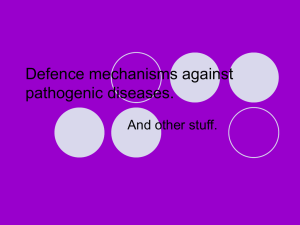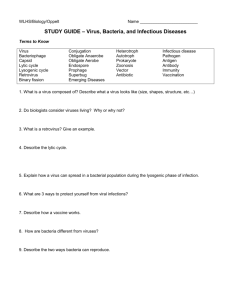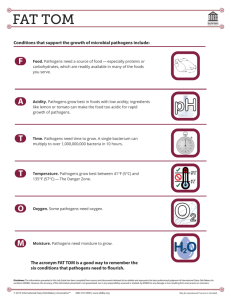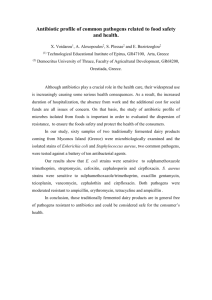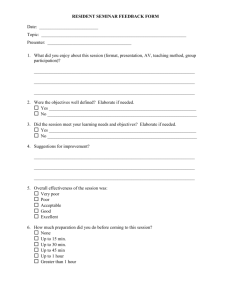Name
advertisement
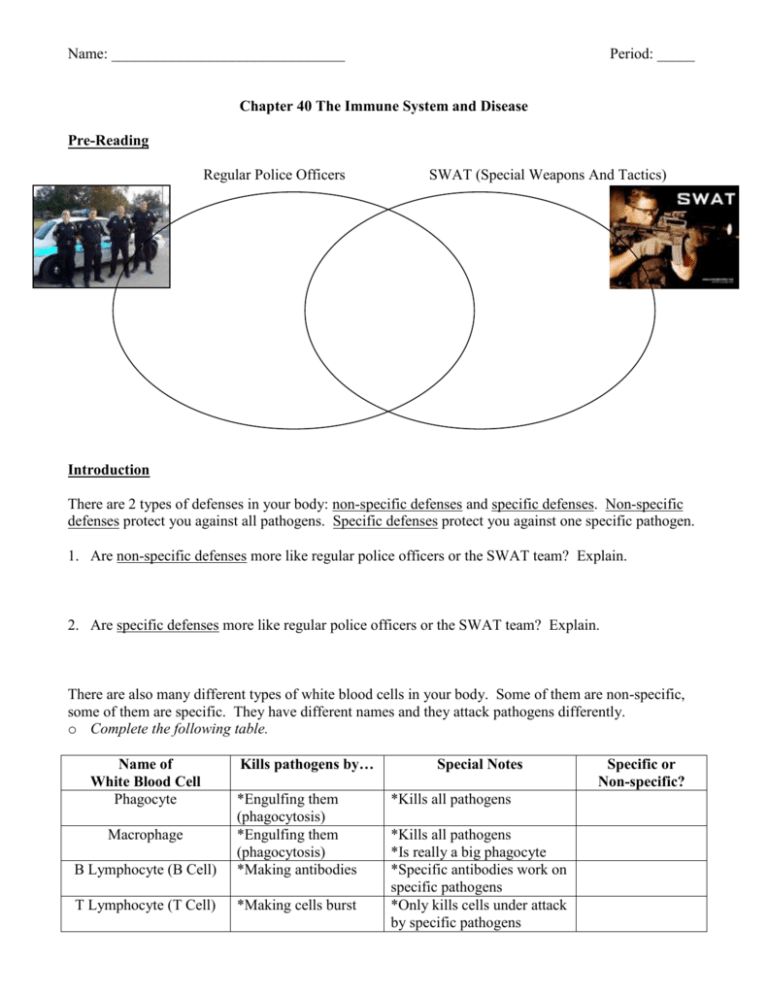
Name: _______________________________ Period: _____ Chapter 40 The Immune System and Disease Pre-Reading Regular Police Officers SWAT (Special Weapons And Tactics) Introduction There are 2 types of defenses in your body: non-specific defenses and specific defenses. Non-specific defenses protect you against all pathogens. Specific defenses protect you against one specific pathogen. 1. Are non-specific defenses more like regular police officers or the SWAT team? Explain. 2. Are specific defenses more like regular police officers or the SWAT team? Explain. There are also many different types of white blood cells in your body. Some of them are non-specific, some of them are specific. They have different names and they attack pathogens differently. o Complete the following table. Name of White Blood Cell Phagocyte Kills pathogens by… B Lymphocyte (B Cell) *Engulfing them (phagocytosis) *Engulfing them (phagocytosis) *Making antibodies T Lymphocyte (T Cell) *Making cells burst Macrophage Special Notes *Kills all pathogens *Kills all pathogens *Is really a big phagocyte *Specific antibodies work on specific pathogens *Only kills cells under attack by specific pathogens Specific or Non-specific? Body’s 1st Line of Defense Talk to the text & write summary statements in margin. The function of the first line of defense is to keep pathogens out of the body. This role is carried out by the Integumentary System, which includes the skin, mucus, sweat, and tears. Your body's most important nonspecific defense is the skin. Very few pathogens can penetrate the layers of dead cells at the skin's surface. The importance of the skin as a barrier against infection becomes obvious as soon as the skin is broken. When that happens, pathogens can enter your body and multiply. As they grow, they cause the symptoms of an infection, such as swelling, redness, and pain. Many secretions of the body, including mucus, saliva, and tears, contain lysozyme, an enzyme that breaks down the cell walls of many bacteria. In addition, oil and sweat glands in the skin produce an acidic environment that kills many bacteria. Pathogens can also enter your body through other body openings, including your mouth and nose. Your body has other nonspecific defenses that protect these openings. Mucus in your nose and throat helps to trap pathogens. The cilia that line your nose and throat help to push pathogens away from your lungs. Stomach acid and digestive enzymes destroy many pathogens that make their way to your stomach. 1. The body’s 1st line of defense is the _______________________ System, which includes… 2. Is the body’s 1st line of defense non-specific or specific? Explain. 3. Choose 3 important keywords and complete the following SEEI boxes. State Elaborate State Elaborate State Elaborate Example Illustrate Example Illustrate Example Illustrate 4. Write a 25-word summary about the body’s 1st line of defense. Body’s 2nd Line of Defense Talk to the text & write summary statements in margin. If pathogens do manage to enter your body, they may multiply quickly, releasing toxins into your tissues. When this happens, the inflammatory response—a second line of defense—is activated. The inflammatory response is a nonspecific defense reaction to tissue damage caused by injury or infection. Damaged tissues release histamines, a chemical that dilates blood vessels and increases blood flow to the injured area. Increased blood flow brings white blood cells, which move from the vessels to enter the infected tissues. Many of these white blood cells are phagocytes, which engulf and destroy bacteria. Increased blood flow also brings platelets, which form blood clots. Due to increased blood flow to the area, infected tissue may become swollen and painful. The immune system also releases chemicals that increase the core body temperature. You may have experienced this elevated body temperature, called a fever. The increased body temperature is advantageous because many pathogens can survive only within a narrow temperature range. An elevated temperature slows down or stops the growth of such pathogens. The higher body temperature also increases the heart rate so that the white blood cells get to the site of infection faster. Physicians know that a fever and an increased number of white blood cells are two indications that the body is hard at work fighting infection. When viruses enter the body, the body sometimes reacts in a different way. Sometimes, virus-infected cells produce a group of proteins that help other cells resist viral infection. Scientists named these proteins interferons because they “interfere” with the growth of the virus. Interferons inhibit the synthesis of viral proteins in infected cells and help block viral replication. This process slows down the progress of infection and often gives the specific defenses of the immune system time to respond. Another group of cells called Natural Killer Cells also help by attacking any body cells infected by viruses by making them burst, therefore also killing the viruses. 1. The body’s 2nd line of defense is called the _______________________ Response. 2. Is the body’s 2nd line of defense non-specific or specific? Explain. 3. Complete the following SEEI boxes. (This time I already picked the words for you) State Elaborate Inflammatory Response State Elaborate Platelets State Elaborate Interferons Example Illustrate Example Illustrate Example Illustrate State Elaborate State Elaborate State Elaborate Histamine Example Fever Illustrate Example Natural Killer Cells Illustrate Example Illustrate 4. If you get hurt, describe the Inflammatory Response in 4 steps. (See paragraph #1) a. b. c. d. 5. Write a 25-word summary about the body’s 2nd line of defense. Body’s 3rd Line of Defense o Take a wild guess if this line of defense is specific or non-specific? ______________________ o We will learn about the 3rd Line of Defense later. Stay tuned.
